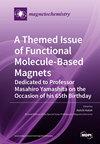NiFe Alloy Nanoparticles Tuning the Structure, Magnetism, and Application for Oxygen Evolution Reaction Catalysis
IF 2.5
4区 化学
Q2 CHEMISTRY, INORGANIC & NUCLEAR
引用次数: 0
Abstract
In this study, Ni-Fe alloy nanoparticles were prepared using the proteic sol–gel method, followed by a reduction in H2 at 500 and 700 °C, namely hereafter as NiFe-500 and NiFe-700, respectively. The morphological, structural, and magnetic properties were tuned via the thermal treatment in H2. The samples were studied using XPS, TEM, Mössbauer spectroscopy, DC magnetic measurements, and electrochemical measurements. Ritveld refinements showed that the sample NiFe-500 has FCC (face-centered cubic) and BCC (body-centered cubic) NiFe alloys, while the sample NiFe-700 has only FCC NiFe alloy. For both samples, magnetization measurements in the range of 300–900 K showed the presence of the Griffiths phase, indicating the formation of clusters of either Fe or Ni-Fe alloys rich in Fe. The sample NiFe-500 presented ferromagnetic (FM) transitions at 533, 700, and 834 K, assigned to the alloys Ni37Fe63-FCC, Ni46Fe54-FCC, and Ni55Fe45-FCC, respectively. In contrast, we could not observe the FM transition of the BCC Ni-Fe alloy because of limitations in our experimental setup (T ≤ 900 K). Meanwhile, three FM transitions were observed for the sample NiFe-700 at 480, 655, and 825 K, attributed to the alloys Ni34Fe66-FCC, Ni43Fe57-FCC, and Ni54Fe46-FCC, respectively. At 5 K, the samples NiFe-500 and NiFe-700 have saturation magnetizations of 164.2 and 173.6 emu g−1, respectively. For application in Oxygen Evolution Reaction catalysis, the samples NiFe-500 and NiFe-700 showed different overpotentials of 319 and 307 mV at 10 mA cm−2. These low overpotential values indicate a higher electrochemical activity of the FCC Ni-Fe alloy and, for both samples, a superior electrocatalytic activity in comparison to RuO2 e IrO2 conventional catalysts. Furthermore, the samples showed high electrochemical stability in chrono potentiometric studies for up to 15 h. This current work highlights that the Ni-Fe alloys produced via the proteic sol–gel and with a reduction in H2 methods can be promising for OER systems due to their good performance and low costs.NiFe合金纳米颗粒的结构、磁性及其在析氧反应催化中的应用
在本研究中,使用蛋白质溶胶-凝胶法制备了Ni-Fe合金纳米颗粒,然后在500和700°C下还原H2,即下文中分别称为NiFe-500和NiFe-700。通过在H2中的热处理来调节形态、结构和磁性能。使用XPS、TEM、穆斯堡尔谱、直流磁测量和电化学测量对样品进行了研究。Ritveld精炼表明,样品NiFe-500具有FCC(面心立方)和BCC(体心立方)NiFe合金,而样品NiFe-700仅具有FCC NiFe合金。对于这两个样品,在300–900 K范围内的磁化测量显示存在Griffiths相,表明形成了富含Fe的Fe或Ni-Fe合金团簇。样品NiFe-500在533700和834K处呈现铁磁(FM)跃迁,分别归属于合金Ni37Fe63-FCC、Ni46Fe54-FCC和Ni55Fe45-FCC。相反,由于实验装置的限制(T≤900K),我们无法观察到BCC-Ni-Fe合金的FM转变。同时,样品NiFe-700在480、655和825K下观察到三次FM跃迁,分别归因于合金Ni34Fe66-FCC、Ni43Fe57-FCC和Ni54Fe46-FCC。在5K下,样品NiFe-500和NiFe-700的饱和磁化率分别为164.2和173.6 emu g−1。对于在析氧反应催化中的应用,样品NiFe-500和NiFe-700在10 mA cm−2下显示出319和307 mV的不同过电位。这些低的过电位值表明FCC Ni-Fe合金具有更高的电化学活性,并且对于这两种样品,与RuO2-ErO2常规催化剂相比具有优异的电催化活性。此外,样品在计时电位研究中显示出高达15小时的电化学稳定性。目前的工作强调,通过蛋白质溶胶-凝胶和减少H2方法生产的Ni-Fe合金由于其良好的性能和低成本,有望用于OER系统。
本文章由计算机程序翻译,如有差异,请以英文原文为准。
求助全文
约1分钟内获得全文
求助全文
来源期刊

Magnetochemistry
Chemistry-Chemistry (miscellaneous)
CiteScore
3.90
自引率
11.10%
发文量
145
审稿时长
11 weeks
期刊介绍:
Magnetochemistry (ISSN 2312-7481) is a unique international, scientific open access journal on molecular magnetism, the relationship between chemical structure and magnetism and magnetic materials. Magnetochemistry publishes research articles, short communications and reviews. Our aim is to encourage scientists to publish their experimental and theoretical results in as much detail as possible. Therefore, there is no restriction on the length of the papers. The full experimental details must be provided so that the results can be reproduced.
 求助内容:
求助内容: 应助结果提醒方式:
应助结果提醒方式:


